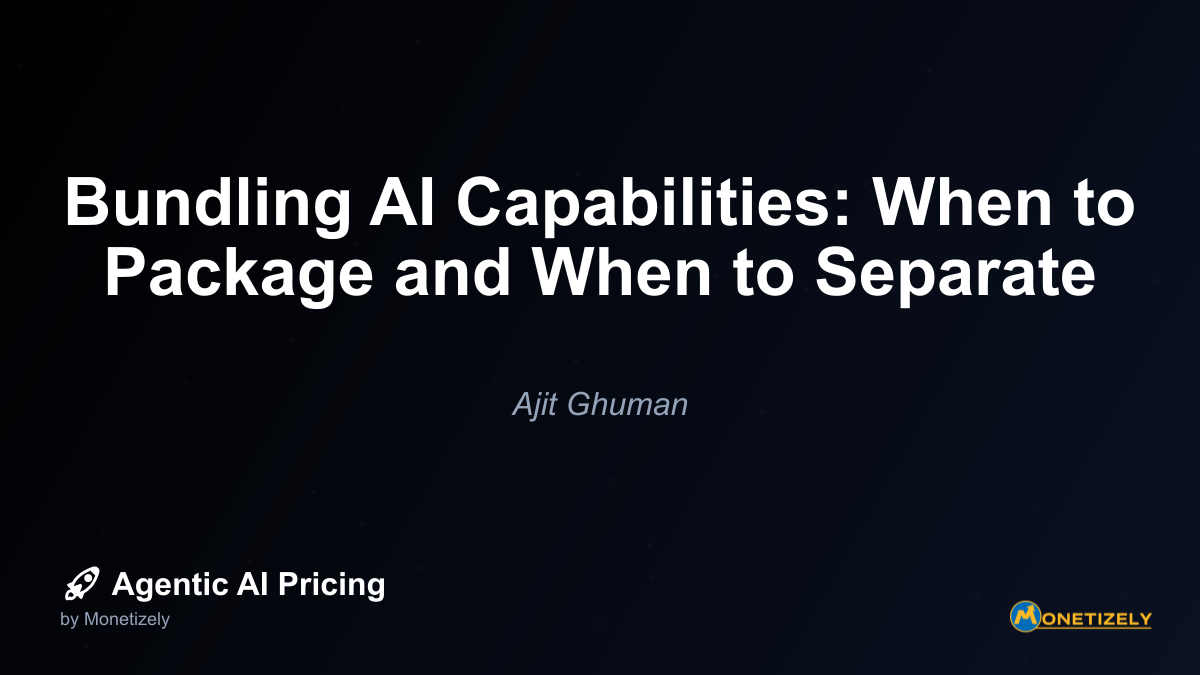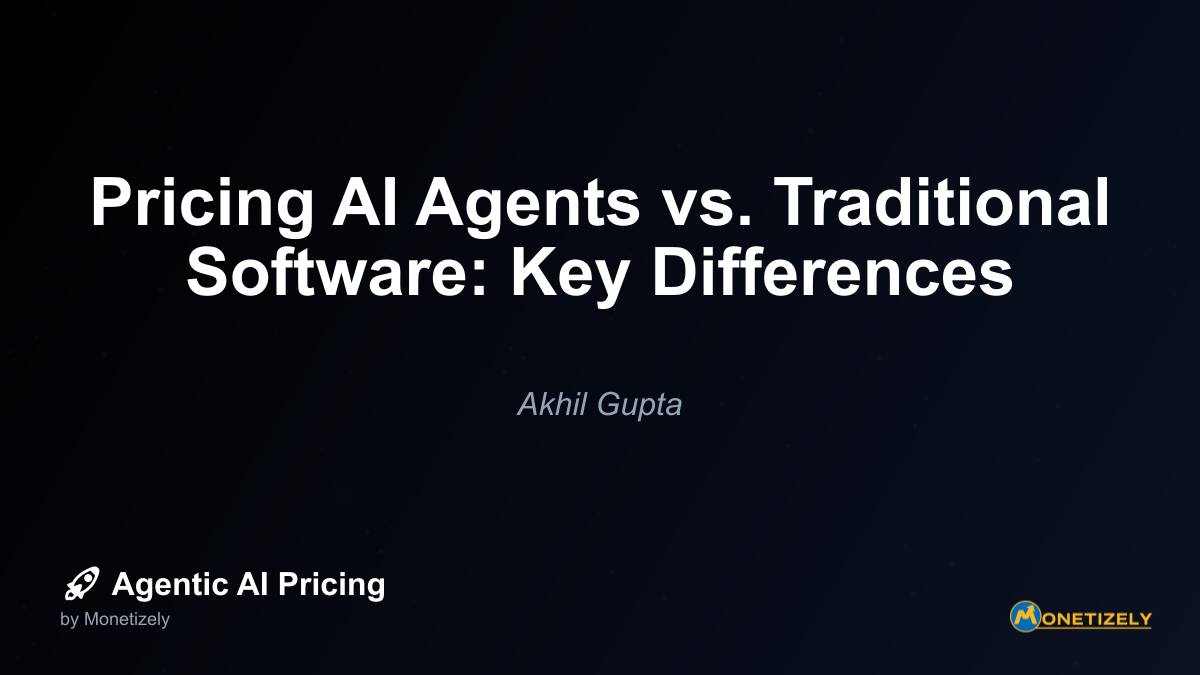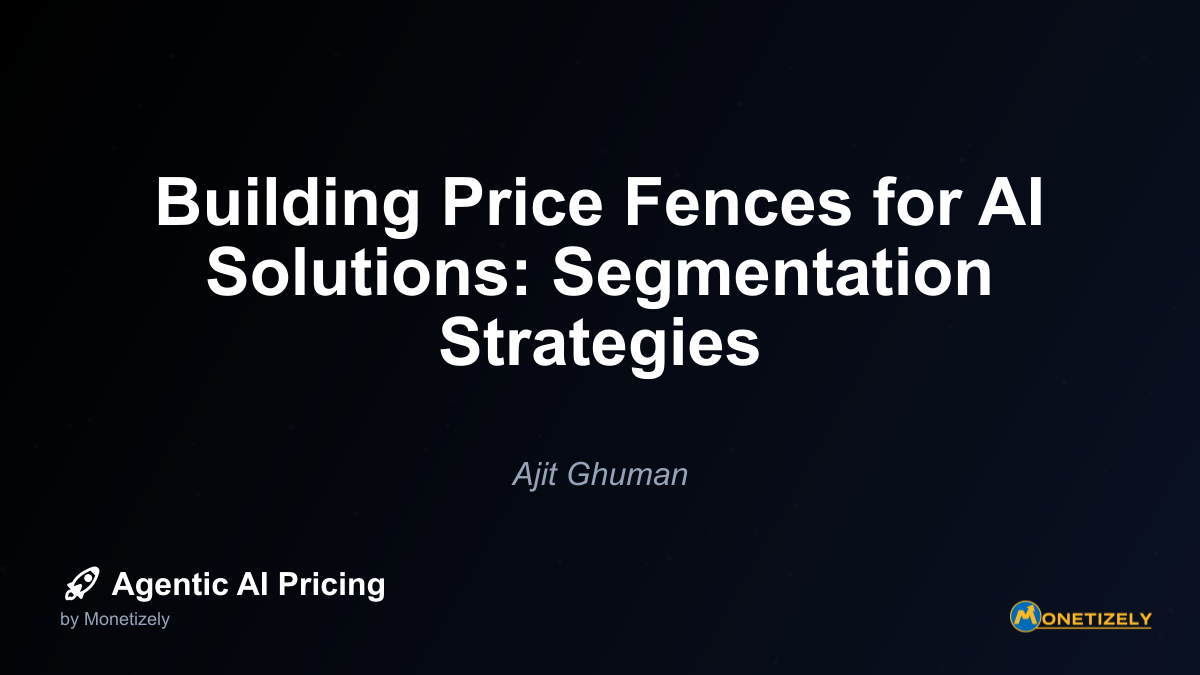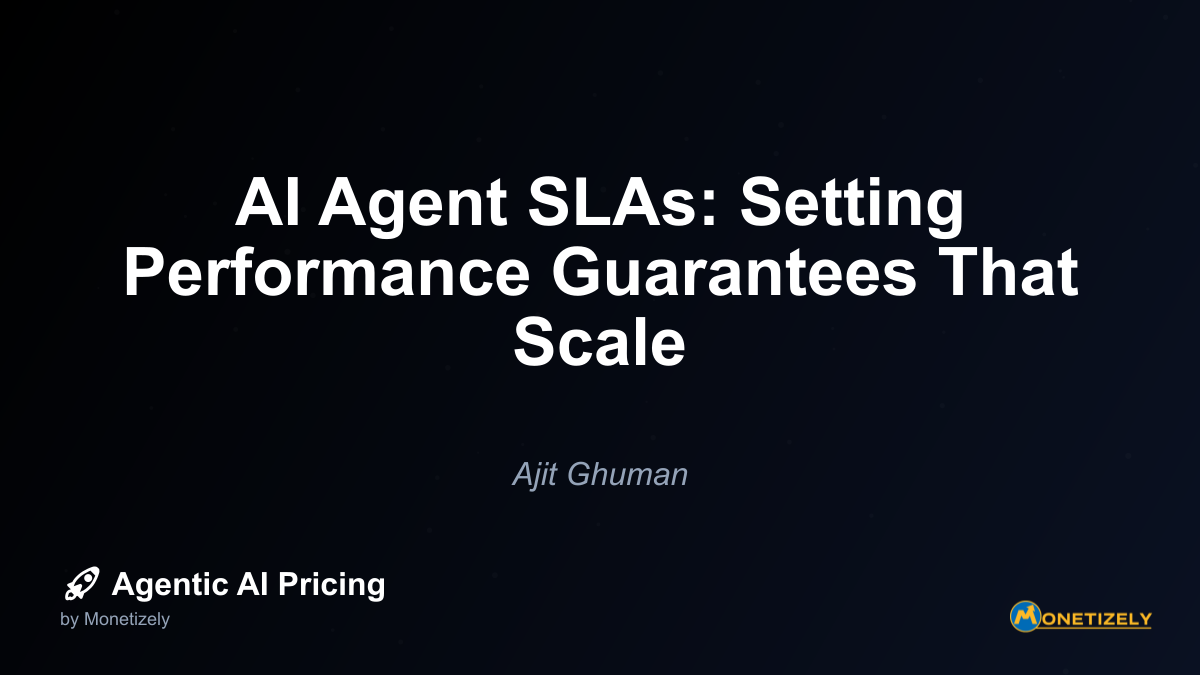· Ajit Ghuman · Packaging & Bundling · 10 min read
Bundling AI Capabilities: When to Package and When to Separate
AI and SaaS Pricing Masterclass
Learn the art of strategic pricing directly from industry experts. Our comprehensive course provides frameworks and methodologies for optimizing your pricing strategy in the evolving AI landscape. Earn a professional certification that can be imported directly to your LinkedIn profile.

For agentic AI companies specifically, bundling decisions carry additional weight. These decisions not only impact revenue but also shape how customers perceive and interact with autonomous AI capabilities. Let’s explore when bundling makes strategic sense and when separating AI features might be the better approach.
The Case for Bundling AI Capabilities
Bundling multiple AI capabilities into a unified offering can create significant advantages under the right conditions. Here are the primary scenarios where bundling makes strategic sense:
1. When Features Create Synergistic Value
The most compelling case for bundling occurs when AI capabilities work together to deliver value greater than the sum of their parts. When features complement each other, bundling creates a powerful value proposition that’s difficult to match.
Example: An AI-powered sales enablement platform might combine conversation intelligence, real-time coaching, and post-call analysis. These capabilities deliver exponentially more value together than they would separately, as they create a complete feedback loop for sales representatives.
2. When Simplifying the Customer Experience
Complex AI capabilities can intimidate potential users. Bundling simplifies the buying and onboarding process by packaging related features into intuitive solutions that address specific use cases or pain points.
Example: A customer service AI platform might bundle sentiment analysis, intent recognition, and automated response capabilities into a single “Customer Service Intelligence” package rather than requiring customers to understand and purchase each capability separately.
3. When Driving Adoption of New Capabilities
Established AI products can leverage bundling to introduce new capabilities to their user base. By including new features within existing packages, companies can accelerate adoption and gather valuable usage data.
Example: A document processing AI might add image recognition capabilities to its core text analysis package, allowing users to discover and experiment with the new functionality without making a separate purchasing decision.
4. When Competing Against Point Solutions
Bundling creates competitive differentiation against point solutions by offering comprehensive value. When facing competition from specialized tools, bundling allows you to position your offering as the complete solution.
Example: An AI marketing platform might bundle content generation, campaign optimization, and performance analytics to compete against specialized tools that only address one aspect of the marketing workflow.
5. When Reducing Price Sensitivity
Strategic bundling can mask the individual prices of high-value features, reducing price sensitivity and creating the perception of greater overall value. This approach works particularly well when bundling high-margin AI capabilities with features that have lower perceived value but high actual value.
Example: An AI data analysis platform might bundle its premium predictive analytics capability (high perceived value) with data preparation features (lower perceived value but critical functionality), creating a package that justifies a premium price point.
When to Separate AI Capabilities
While bundling offers clear advantages in many scenarios, there are equally compelling reasons to keep AI capabilities separate:
1. When Capabilities Serve Different User Segments
If your AI features appeal to distinctly different user segments with minimal overlap, bundling may dilute your value proposition and confuse potential customers.
Example: An AI platform for creative professionals might separate its video editing AI from its music composition AI, as these tools serve different creative disciplines with unique workflows and requirements.
2. When Usage Patterns Vary Dramatically
AI capabilities with dramatically different usage patterns or consumption models may be better suited to separate offerings with tailored pricing structures.
Example: An enterprise AI platform might separate its high-volume document processing capability (priced per document) from its strategic decision support AI (priced per seat), as these capabilities follow fundamentally different consumption patterns.
3. When Capabilities Have Different Maturity Levels
Emerging AI capabilities often require different go-to-market strategies than established features. Separating cutting-edge capabilities allows for more flexible pricing and positioning while protecting the value perception of core offerings.
Example: A customer data platform might offer its experimental predictive customer lifetime value model as a separate add-on to its established customer segmentation AI, allowing early adopters to access the new capability without disrupting the core product experience.
4. When Premium Capabilities Drive Upsell Opportunities
Separating high-value AI capabilities creates natural upsell paths and allows for premium pricing of specialized features that deliver exceptional value to specific customer segments.
Example: A business intelligence platform might offer its core data visualization AI in its standard package while positioning its advanced scenario modeling capability as a premium add-on for strategic planning teams.
5. When Cost Structures Differ Significantly
AI capabilities with substantially different cost structures may require separate pricing models to maintain profitability. Unbundling allows for tailored pricing that accurately reflects the underlying economics of each capability.
Example: An AI content platform might separate its computationally intensive video generation feature (high variable costs) from its more efficient text generation capability (lower variable costs) to implement appropriate pricing for each.
The Mixed Bundling Approach for AI Products
Rather than choosing exclusively between bundling and separating, many successful AI companies employ mixed bundling strategies. This approach offers both bundled packages and standalone options, providing maximum flexibility and capturing value across different customer segments.
Mixed bundling is particularly effective for agentic AI products because it accommodates diverse customer needs while creating multiple paths to monetization.
Example: A comprehensive AI assistant platform might offer:
- A core package with document processing and basic automation
- Industry-specific bundles that combine relevant capabilities for healthcare, legal, or financial services
- Premium add-ons for specialized capabilities like advanced analytics or custom model training
- Enterprise bundles that include all capabilities with volume-based pricing
This approach allows customers to start with the core functionality and expand their usage over time, while giving the company multiple opportunities to capture value.
A Framework for AI Bundling Decisions
When evaluating bundling options for your AI capabilities, consider these key factors:
1. Customer Value Perception
How do customers perceive the relationship between your AI capabilities? Do they view them as complementary parts of a solution or as distinct tools serving different purposes?
Assessment questions:
- Do customers typically need multiple capabilities to achieve their goals?
- Do capabilities create more value when used together than separately?
- Would separating capabilities create friction in the customer experience?
2. Technical Integration and Dependencies
How deeply integrated are your AI capabilities from a technical perspective? Are there significant dependencies or shared infrastructure?
Assessment questions:
- Do capabilities share underlying models or data sources?
- Would separating capabilities require duplicating infrastructure?
- How modular is your architecture?
3. Cost Structure Analysis
What are the cost implications of bundling versus separating your AI capabilities?
Assessment questions:
- Do capabilities have similar or different cost drivers?
- How do fixed versus variable costs compare across capabilities?
- Would bundling create economies of scale or operational efficiencies?
4. Competitive Positioning
How does your bundling strategy position you against competitors in the market?
Assessment questions:
- Are competitors offering bundled or unbundled solutions?
- Is there an opportunity to differentiate through your packaging approach?
- Would bundling create a more compelling value proposition against alternatives?
5. Revenue Optimization
Which approach maximizes both immediate revenue and long-term customer value?
Assessment questions:
- Would bundling increase average deal size but reduce total addressable market?
- Does separating capabilities create more upsell opportunities?
- Which approach aligns better with customer budget processes?
Real-World AI Bundling Examples
Looking at how leading AI companies approach bundling provides valuable insights:
OpenAI’s Tiered Model Approach
OpenAI offers a tiered approach to its AI capabilities:
- Free tier with basic GPT access
- Plus subscription bundling higher usage limits and priority access
- Team and Enterprise tiers bundling advanced features, higher rate limits, and security features
- Separate API pricing for developers
This strategy allows OpenAI to serve different market segments while creating clear upgrade paths based on value and usage requirements.
Anthropic’s Claude Product Strategy
Anthropic has taken a different approach with Claude:
- Initially offering a unified product with tiered performance levels (Claude, Claude Instant)
- Gradually introducing specialized capabilities (Claude 3 Opus, Sonnet, Haiku)
- Creating both bundled experiences through their application and unbundled access through API
This strategy allows Anthropic to target different use cases and performance requirements while maintaining a coherent product identity.
Microsoft Copilot’s Ecosystem Approach
Microsoft has implemented a hybrid bundling strategy for its Copilot offerings:
- Core Copilot for Microsoft 365 bundling AI capabilities across Office applications
- Specialized Copilots for specific domains (GitHub, Security, Sales)
- Enterprise licensing that bundles multiple Copilots
- Add-on pricing for specialized features and customizations
This approach leverages Microsoft’s existing ecosystem while creating new value through AI integration and specialization.
Implementation Considerations for AI Bundling
Once you’ve determined your bundling strategy, consider these implementation factors:
1. Pricing Architecture
Your bundling decisions must be reflected in a coherent pricing architecture that communicates value clearly to customers.
Key considerations:
- Price points that reflect the value differential between bundled and unbundled options
- Discount structure that incentivizes bundle adoption without devaluing individual capabilities
- Clear value metrics that align with customer outcomes
2. Packaging Communication
How you communicate your packaging strategy significantly impacts customer understanding and adoption.
Key considerations:
- Clear naming convention that communicates the purpose and value of each bundle
- Feature groupings that make intuitive sense to customers
- Visual representation of your packaging structure that highlights value differences
3. Migration Strategy
If you’re changing your bundling approach, you need a thoughtful migration strategy for existing customers.
Key considerations:
- Grandfathering policies for existing customers
- Incentives to migrate to new packaging structures
- Communication timeline and messaging
4. Flexibility for Future Evolution
AI capabilities evolve rapidly, so your bundling strategy should accommodate future changes.
Key considerations:
- Modular architecture that allows for reconfiguration
- Contract terms that permit package evolution
- Customer communication channels for introducing new capabilities
Measuring Bundling Effectiveness
To evaluate the success of your AI bundling strategy, track these key metrics:
1. Bundle Adoption Rate
What percentage of customers choose bundled options versus individual capabilities?
2. Bundle Efficiency
How does the cost of selling and supporting bundled offerings compare to unbundled alternatives?
3. Feature Utilization Within Bundles
Are customers actively using all capabilities within bundles, or are some features going unused?
4. Average Revenue Per User (ARPU)
Has bundling increased overall revenue per customer?
5. Customer Expansion Rate
Are customers who start with individual capabilities upgrading to bundles over time?
Common Bundling Pitfalls to Avoid
As you develop your AI bundling strategy, be aware of these common mistakes:
1. Over-bundling
Cramming too many disparate features into a single bundle can confuse customers and dilute your value proposition. Focus on creating bundles with clear, cohesive value narratives.
2. Underpricing Bundles
Many companies discount bundled offerings too aggressively, leaving money on the table. Bundles should offer a discount compared to à la carte purchasing but still reflect the combined value of the included capabilities.
3. Rigid Bundle Structures
Fixed, inflexible bundles can frustrate customers who need specific combinations of capabilities. Consider offering some degree of customization, particularly for enterprise customers.
4. Neglecting Bundle Positioning
Bundles need clear positioning that explains why the combined capabilities deliver superior value. Without this narrative, customers may not see the benefit of choosing bundled options.
5. Failing to Evolve Bundles
AI capabilities evolve rapidly, and your bundling strategy should evolve with them. Regularly reassess your packaging approach as you introduce new capabilities and as market conditions change.
AI Bundling Strategy for Different Company Stages
Your approach to bundling should align with your company’s maturity and market position:
Startups
Focus on simple, focused bundles that clearly communicate your core value proposition. Avoid overly complex packaging that could confuse early adopters.
Growth-Stage Companies
Experiment with mixed bundling approaches to identify optimal packaging structures. Use customer feedback and usage data to refine your strategy.
Established Players
Leverage sophisticated bundling strategies that maximize customer lifetime value and create competitive differentiation. Consider industry-specific bundles and enterprise packaging options.
Conclusion: The Strategic Imperative of AI Bundling Decisions
The question of when to bundle AI capabilities versus offering them separately is not merely a tactical pricing decision—it’s a strategic choice that shapes how customers perceive, adopt, and derive value from your technology.
The most successful AI companies approach bundling decisions with a clear understanding of customer needs, technical realities, competitive dynamics, and economic implications. They recognize that bundling strategy is not a one-time decision but an evolving approach that must adapt as capabilities mature and markets evolve.
As you develop your own AI bundling strategy, focus on creating packages that simplify customer decision-making, highlight the unique value of your capabilities, and create natural paths for expansion. Regularly reassess your approach as you introduce new capabilities and as customer needs evolve.
By thoughtfully addressing the bundling question, you’ll not only optimize revenue but also enhance customer experience and strengthen your competitive position in the rapidly evolving AI landscape.
Co-Founder & CEO
Ajit is the author of Price To Scale, a top book on SaaS Pricing and is the Founder of Monetizely. Ajit has led and worked in pricing and product marketing at firms like Twilio, Narvar and Medallia. His work has been featured in Forbes and VentureBeat. Ajit regularly consults with software companies from Seed stage to post-IPO on pricing strategy. Ajit is also a highly-rated co-instructor for 'The Art of SaaS Pricing and Monetization' on Maven.
Pricing Strategy Audit
Let our experts analyze your current pricing strategy and identify opportunities for improvement. Our data-driven assessment will help you unlock untapped revenue potential and optimize your AI pricing approach.




